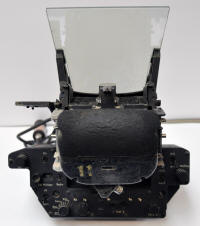 Taking aim Taking aim
Since man first took to the skies he wanted to use the
ability to fight in the air. As soon as the other side started
looking at your side they wanted to get rid of the snooper. It
quickly became obvious that the best platform to do that was
another flying machine.
The early aces were the ones who could calculate where to
shoot when you are in a machine travelling at 100mph at another
doing about the same.
As fighting in the air progressed science started to lend a
hand and gun sights became far more than the simple ring sight
shown here. Initially mechanical aids helped overcome problems
of calculating how far ahead of the other aeroplane to shoot,
and to overcome drift caused by the wind. Later on this became
more and more complex, until today's head-up displays show much
more information than where your bullets are going to end up.
Gun sights also became bomb sights and missile and rocket firing
sights. Radar started to be used as well as quite complex
computers.
 The museum's collection of sights contains examples across
the years from First World War to the mid 1970s, from simple
sights to Head Up displays. The collection started to outgrow
it's cabinet space a few years ago, then we received a legacy
from a former member which allowed us to greatly increase the
amount of sights on display. The museum's collection of sights contains examples across
the years from First World War to the mid 1970s, from simple
sights to Head Up displays. The collection started to outgrow
it's cabinet space a few years ago, then we received a legacy
from a former member which allowed us to greatly increase the
amount of sights on display.
We have also used to opportunity to get a more of the sights
working so that visitors can see what the pilot/gunner would
have seen when using them. The working electrical sights are
operated by a push button system which runs that sight for about
a minute, and visitors can take aim at our targets (actually tie
pin aircraft pinned to the back of the cabinet). Unfortunately
getting the later radar sights to work is too difficult, and
would require too much power, but there are seven electrical
sights as well as three mechanical ones that visitors can see
working.
We have also provided additional information on the sights
via a Raspberry Pi computer with a small touchscreen showing an
intranet site.
This display has been created in memory of member Malcolm
Lowe.
|

